
Dewey Martin’s post-Buffalo Springfield career has never received the attention bestowed to his fellow cohorts Steve Stills, Neil Young and Richie Furay.
Like his erstwhile colleague, bass player Bruce Palmer, Martin (b. Walter Milton Dewayne Midkiff, 30 September 1940, Chesterville, near Ottawa, Canada; d. 31 January 2009, Van Nuys, California) struggled to maintain a profile in the aftermath of Buffalo Springfield’s premature demise.
While Stills and Young found international stardom in the super group Crosby, Stills, Nash & Young and as successful solo artists, and Furay as founder and guiding light of country-rock pioneers Poco, Martin’s own projects, the ill-fated New Buffalo Springfield and Medicine Ball quickly faded into obscurity.
The fact that he revived the name of his former group suggests that Martin recognised his best hope of securing a musical future lay in carrying on where the old group had left off.
Yet when Buffalo Springfield performed their final date on 5 May 1968, the prospect of anyone reviving the band’s name was an unlikely proposition.
Initially, Martin’s plans involved going on the road as a duo with his wife Jane, but this idea never progressed beyond the statement he made to the music press that spring. It is also understood that he did some recordings with Paul Williams’ band Holy Mackerel during this period.
According to a Teen Set press release from August 1968, the married couple spent the best part of the summer playing golf, while Martin looked around for suitable players to back him in an unnamed group specialising in soul, country, blues and jazz.
A month or two later, Martin’s band began to take on shape with the recruitment of four musicians that he’d spotted playing at a club in Phoenix, Arizona.
Bass player Bob Apperson, drummer/vocalist Don Poncher (b. 29 July 1947, Chicago, Illinois), horn player Jim Price (b. 23 July 1945, Fort Worth, Texas) and lead guitarist Gary Rowles (b. 24 January 1943, New York) were friends from the San Fernando Valley in California, but had only been playing together as a band for a month when Martin discovered them.
Rowles, who was the son of famous jazz pianist, Jimmy Rowles, had organised the quartet after leaving his previous employer Nooney Rickett and his group, The Noon Express.
Prior to the quartet’s formation, Apperson and Poncher had first worked together with future Blue Rose guitarist John Uribe in power trio Brothers Keepers in the San Fernando Valley.
Apperson had joined the trio around 1967 after playing in the final incarnation of surf group, The Dartells while Poncher had gravitated to rock music after first working for country artist Tex Williams when he was 16-years-old.
According to Poncher, it was Rowles who brought in Jim Price to complete the quartet.
With the core of the band formed, Martin added another Texan, former Armadillo rhythm guitarist/vocalist David Price (b. 23 September 1944, Ballinger, Texas), an old college friend of Mike Nesmith’s from San Antonio who’d been closely involved with The Monkees’ studio work and previously worked with Austin, Texas group, The Chelsea.
David Price had also acted as Davy Jones’s stand in for the TV series and also appeared as an extra in many of the episodes of the popular TV show, most notably as the chemist in The Prince and The Pauper.
“Mike [Nesmith] called and said Dewey Martin was auditioning a post-Buffalo Springfield band at his house in the hills and suggested I come up and check it out,” remembers Dave Price. “I had known Dewey from The Monkees tour days.”
In late October, Martin’s group drove up to Boulder, Colorado to rehearse material (mixing old Springfield songs with band originals like Jim Price’s “The Pony Express Man”) and to play some warm up gigs at a local dinner club for a few weeks.
According to Jerry Fuentes’ research, the musicians held down a brief residency at the Function in Boulder from 22 October to 8 November, opening for The Everly Brothers.
It may well have been during this period that the decision was made to adopt the Buffalo Springfield moniker.
According to Gary Rowles, none of the group was a party to the decision and only realised the fact when they started turning up at concerts, only to find the band billed as “New Buffalo Springfield”.
The fateful decision to use the name would subsequently lead Rowles and others to desert Martin’s band once Stills and Young took legal action and the guitarist suspects the band’s manager, Mike Zalk, was instrumental in persuading Martin to use the name.
Dave Price concurs: “Mike Zalk was always out for a quick buck, so whatever he could book us as, he would.”
The New Buffalo Springfield soon hit the road and on 15 November performed at San Luis Obispo Junior High School and Gym with The Mynd and Wendigo.
The group then flew out to Hawaii for a show the following day, opening for The Turtles and Canned Heat at the Honolulu International Center.
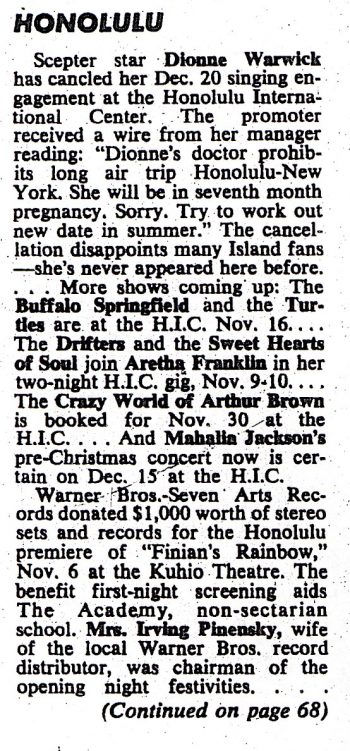
“It was the first time I’d played with 50,000 people all surrounding me and I was on a 20-foot high stage,” says Poncher.
“I was about six feet above the band, so that’s something you never forget. It was really quite overwhelming.”
Back in California, the musicians performed at the Sound Factory in Sacramento on 23 November, on a bill that also included Mad River and Sanpaku.
A week later, on 30 November (and billed as The Buffalo Springfield) they supported The Sir Douglas Quintet at the Terrace Theatre in Salt Lake City.
One of the most notable shows was opening for Eric Burdon & The Animals at the Swing Auditorium, Orange Show Grounds in San Bernadino on 6 December where the group was once again billed as “The Buffalo Springfield”.
The next day, The Buffalo Springfield joined Charlie Musselwhite, Three Dog Night and Sields for a gig at the Earl Warren Showgrounds in Santa Barbara.

More shows low-key gigs followed. Neither Stills nor Young were in California at the time, and it was only later when they caught wind of what was happening.
In fact, it was probably Furay who alerted them to the deception after his new outfit (then called Pogo) performed in San Francisco on 25-26 December, the same time that Martin’s bogus group was playing across town.
On that occasion, Pogo were performing at the Fillmore West in San Francisco while Martin’s band was taking part in the highly publicised Holiday Rock Festival, held at the Cow Palace.
The Holiday Rock Festival show on 26 December was New Buffalo Springfield’s most high-profile concert date so far and also featured top acts, Canned Heat, Santana, The Electric Prunes and Steppenwolf among others.
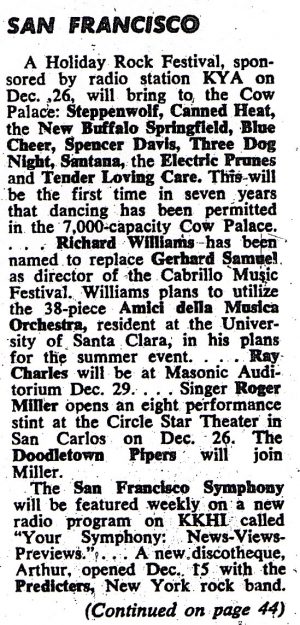
The Thursday before the show, Martin had been interviewed about his new group’s appearance at the festival by journalist Peggy King for an article in the Oakland Tribune, which was published under the title “A new ‘Buffalo’ in rock roundup” on Saturday, 21 December.
In the interview, Martin revealed that the show would include nine songs by the group, half old songs with the new sound and the rest new “Springfield” originals. A conglomeration of jazz, rock and blues.
“We have a more powerful sound that’s the way I would compare it with the old group,” Martin told King. “Before it was east-going country-western. Now we’ve added some electronic sound devices and Jim Price on amplified trumpet and trombone.”
Martin goes on to explain that after the show, the band will “finish mapping out an album for Atlantic” (more of which later) and also reveals that, “we’re booked up pretty solid with jobs. We just take them as they come and try to do our best with each one, no big plans.”
A week or so before the Holiday Rock Festival, the band had driven up to the Pacific Northwest, Martin’s old stomping ground and performed, somewhat mischievously, under the “Buffalo Springfield” banner at several venues – the Pacific Coliseum in Vancouver on 21 December and the Memorial Coliseum in Portland, both opening for The Chambers Brothers and The Buddy Miles Express.
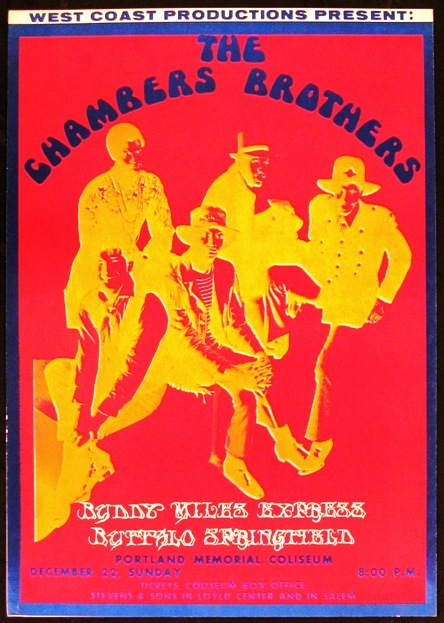
They also appeared at the Evergreen Ballroom in Olympia, Washington on 23 December, with The White Hearts in support.
Olympia was small enough to get away with such a stunt but the Holiday Rock Festival had received too much publicity for Mike Zalk to risk billing the group as simply “The Buffalo Springfield”.
Even so, according to Rowles, the manager pulled out all the stops to publicise the band’s performance at the festival and hired some local help to ensure that its limos arrived on time.
“The Hell’s Angels escorted us from the Fairmont Hotel to the Cow Palace gig – we didn’t have to stop once, and it was an amazing journey, to say the least.”
“I remember the Hell’s Angels breaking us into the back door of the Cow Palace even though we were an act there working,” adds Poncher.
“They broke down the door and maced one of the cops. They wanted to help us with our gear on stage. They unplugged the entire stage and the whole house went dark for a couple of minutes.”
“The Cow Palace was a real disaster,” remembers Dave Price, who has his own take on the event.
“We were supposed to go on relatively late in the day; we were fairly high on the bill and [Zalk] thought that if we just go over there and walk on stage and do our stuff, we’d just fade into the woodwork, so we needed to make a big splash.
“When we finally went on stage, the Hell’s Angels all went out and stood around the stage like they were our protectors and everybody in the place booed us something fierce. We really had a hard time. It was not a good show.”
Despite the reception, many no doubt had been led to believe that the original group had reformed for a one-off date. Having caught wind of Martin’s activities, Furay presumably contacted Stills, who was back in L.A. in early 1969 after a brief stint in London rehearsing his new project, Crosby, Stills & Nash.
On 11 January 1969 Martin’s group, billed as The Buffalo Springfield, appeared at San Diego Community Course with The Sir Douglas Quintet.
As with all of the shows the band played, Martin fronted the group on stage, with Poncher handling the drums.
“Dewey mostly would go out front and sing and then he’d come back and we’d double on drums on one song,” remembers Poncher.
Critic Mike Martin, who was in attendance, was not convinced and felt the “whole scene was a cheap ride on the well-earned fame of The Buffalo Springfield. Regrettably, someone is making money off the deception.”
On 17 January, The Buffalo Springfield joined The Steve Miller Band, Black Pearl, Three Dog Night and Jet Set for a show at the Convention Center in Anaheim, California.
Soon afterwards, Stills and Young took legal action to prevent their former drummer from using the name.
Martin retaliated but subsequently lost the case, and with it his royalties. Nonetheless, he refused to give up and simply shortened the name to New Buffalo, although that didn’t last long.
While all this was going on, Jim Price took the opportunity to find employment elsewhere joining Leon Russell and later Delaney & Bonnie’s backing group.
Bob Apperson and Gary Rowles soon followed Price out the door – Apperson subsequently pursuing session work with the likes of Jose Feliciano among others, while Rowles found employment with Love, the group he’d been asked to join the previous autumn, later appearing on the albums Out Here and False Start.
Don Poncher also decided that he’d had enough and split to do session work.
“It was a dead horse,” sighs the drummer. “You’d go to a job out of state in another town and you’d get to the hotel and somebody would call up your room and say, ‘Hi, is Steve Stills there?’ Erm no.”
In February 1969, Billboard magazine revealed that Martin’s band (called The New Buffalo Springfield) had been signed by Atlantic Records to record an album.
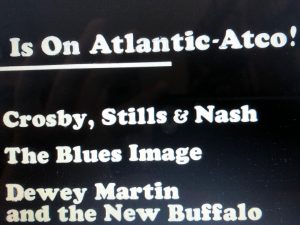
For some reason these plans never materialised and a line up comprising Dewey Martin, Dave Price, lead guitarist Bob “B J” Jones (b. 9 November 1942, Woodbury, New Jersey; d. 15 June 2013, Sioux Falls, South Dakota), who’d previously worked with Little Richard and an obscure band called Danny & The Saints, and former Bobby Fuller Four bass player and singer Randy Fuller (b. 29 January 1944, Hobbs, New Mexico), spent the next few months or so playing venues across the country.
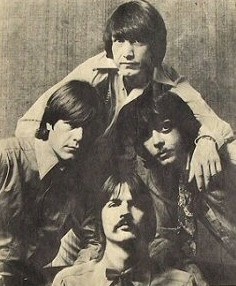
The new formation kicked off with a show at the Mother Duck in Chicago with Hot Fudge on 31 January. Occasionally, the band was billed as Blue Buffalo.
Billed as The Buffalo Springfield, Dewey’s new version then opened for Iron Butterfly at the Civic Auditorium in Albuquerque, New Mexico on 8 February.
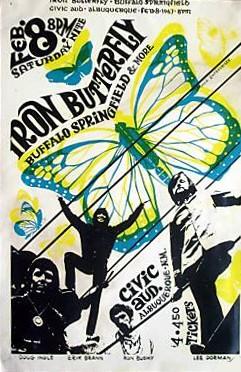
Later that month, again billed under the old name, the quartet joined Canned Heat, The Outsiders and The Seeds for a show at the Mosque in Richmond, Virginia on 23 February.
The following month, on 22 March, The Buffalo Springfield joined a bogus version of the British band The Zombies and Dewey’s old band, The Standells for a show at the 1st Washington Spring Pop Music Festival, held at the Ritchie Coliseum, the University of Maryland.
During the spring, the band played the Easter Rock Festival at Lockhart Park in Fort Lauderdale, Florida alongside top names like Creedence Clearwater Revival, Canned Heat, Steve Miller and The Grass Roots, which ran for three days from 30 March to 1 April.
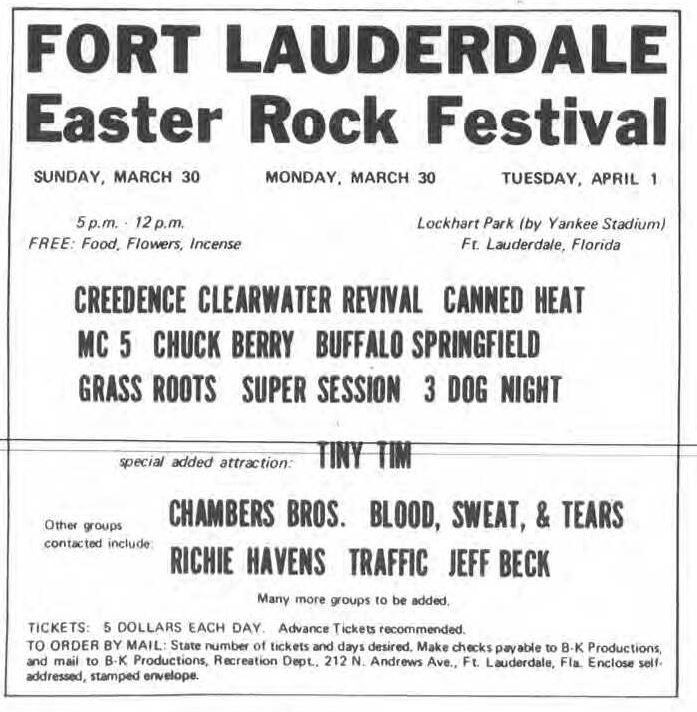
“My whole experience with Dewey was kind of playing off of, one way or another, The Buffalo Springfield, even when it was Blue Buffalo,” admits Price.
“But once we had the four-piece band with Randy and B J, we started trying to write originals and we did do some recording.
“I don’t know how it all transpired but Dewey somehow was able to get some studio time at a studio down in Hollywood. It was either Gold Star or Sunset Sound. We recorded one or two songs of mine and Dewey had some stuff of his that he threw in but it was all very chaotic. We were writing things on the spot. Dewey then sent those tapes to Atlantic.”
As Dave Price recalls, the label was not impressed with the tapes’ quality but sent out producer Tom Dowd to check out Martin’s latest project.
“Dewey had, for whatever reason, brought in Hal Blaine to play on the session,” explains Price.
“Tom Dowd was very hard-nosed about things and rightfully so. He did one session with us and obviously went back to New York and said, ‘This is bullshit’, so nothing came of it.”
In an interesting side note, the rhythm guitarist remembers Martin crossing paths with one of his former Buffalo Springfield cohorts at one of the earlier sessions.
“Before Tom Dowd came into town, Neil Young was recording in the same studio down the hall from us. I didn’t see him myself but all I heard was that he was pissed off with Dewey and whoever we were that he didn’t know.”
Interestingly, Dewey’s band and Neil Young had originally been booked to appear together at the Warehouse India in Providence, Rhode Island on 18 May but the show was cancelled when local officials banned rock shows. Not long afterwards, Young was asked to join Crosby, Stills & Nash.
Sometime in late May or early June, Blue Buffalo/Buffalo Springfield added a second lead guitarist Joey Newman (b. Vern Kjellberg, 29 August 1947, Seattle, Washington), who’d previously worked with Northwest acts Merrilee Rush & The Turnabouts, The Liberty Party and Don & The Good Times, and L.A-based outfit, Touch.
“We got him through Mike Zalk,” remembers Price. “He was from the Northwest and had been in and around all those bands. Zalk decided that B J wasn’t up to the lead guitar chores, which he was, but Mike didn’t think so. B J and I started drifting more into a hard rock sound. We were sort of Jimi Hendrix fans. I think Mike didn’t like that direction so he brought in Joey. He added a whole new dimension to the band.”
The band then set off on a six-week driving tour of the Pacific Northwest, which would test the nerves of everyone involved.
Just before the tour kicked off, the band performed two Californian shows with support acts Mixed Company and Divine Maddness – the first at the Veteran’s Memorial Building in Santa Rosa on 30 May and the second (billed as The New Buffalo Springfield) at the Municipal Auditorium in Eureka the following day.
Reverting back to using The Buffalo Springfield name, the group started off playing two low-key dates in Longview and Westport, Washington state on 6 and 7 June respectively.
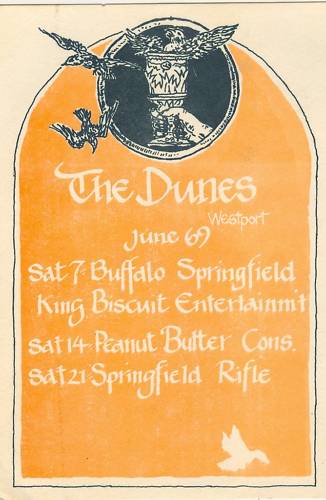
Next up was a performance at Chehalis Civic Auditorium in Chehalis, Washington on 21 June where the group was supported by Slugg.
A succession of shows followed into early July, including one at the Evergreen Ballroom in Olympia on 3 July (where The New Buffalo Springfield had played the previous December), once again billed as The Buffalo Springfield.
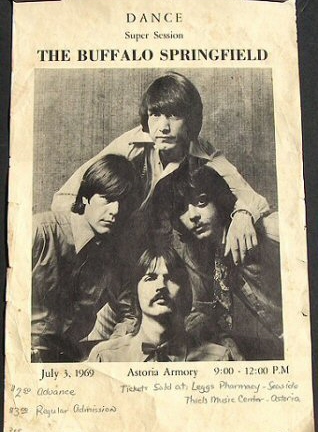
More high-profile dates followed with the band billed as The Buffalo Springfield. These included opening for Paul Revere & The Raiders and The Grass Roots at the Seattle Center Arena on 8-9 July, the Breakthru in Tacoma, Washington on 11 July and another Seattle booking at the Happening on 19 July.
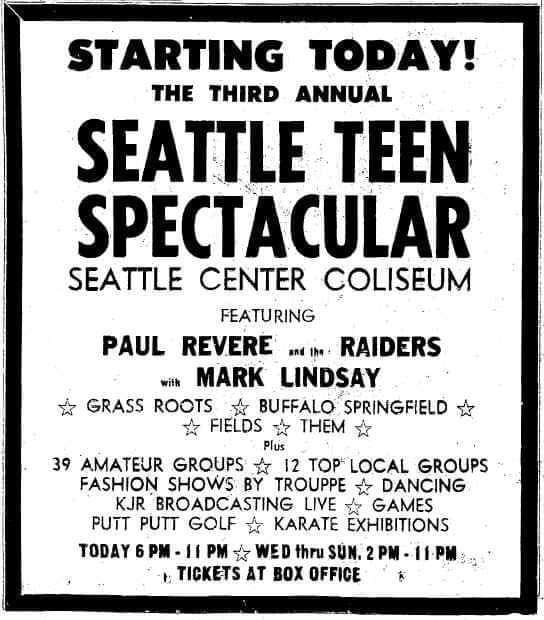
“We did some stuff along the coast and playing places like Moses Lake, Washington, Walla Walla, those sort of things,” says Price. “Hermiston, Oregon was a good one [but] it was mainly a small town tour.”
Soon into the tour, however, the relationship between the band’s leader and the group began to sour.
“Dewey and the rest of the band weren’t really getting on that well,” says Price.
“Dewey had a lot of personal demons and at that time he was really wild and basically a loose cannon, not that all the rest of us weren’t being idiots as well. We came back to L.A and we got together without Dewey and said, ‘This is crazy’ and essentially fired Dewey. Mike Zalk left with us. I don’t know if that was good or bad.”
“Dewey really should have had more success than he did but lacked a ‘song’ and was somewhat a victim of his own excessive behaviour,” adds Joey Newman, on his brief involvement with Martin.
Left without a band, Martin struck lucky and signed a solo deal with Uni Records in October 1969.

Shortly afterwards, he returned to the studio and, abetted by several session musicians (including guitar ace James Burton), he recorded a version of the country favourite “Jambalaya (On the Bayou)” backed by his own composition “Ala-Bam”, as a prospective single.
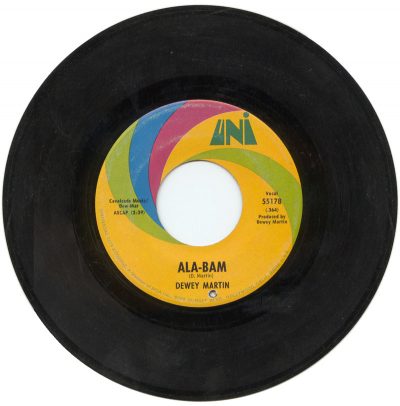
Under the musical direction of Mike Zalk, his former group meanwhile changed its name to Blue Mountain Eagle and recorded an eponymous album for Atco Records under the direction of David Geffen. Listening to it, the record bears all the hallmarks of The Buffalo Springfield sound.
By the time Blue Mountain Eagle’s album finally appeared in the shops in May 1970, Martin had been busy working on his next project, which was a more straightforward country-rock affair.
Many thanks to the following for their generous help: Dewey Martin, Dave Price, Gary Rowles, Don Poncher, Randy Fuller, Joey Newman, Bob Jones, Mike Zalk, John Einarson, Carny Corbett, Trevor Brooke, Derek Atherton and David Peter Housden.
A massive thank you must go to music historian Jerry Fuentes who helped with The New Buffalo Springfield dates found here: http://www.angelfire.com/rock3/deliverin/BUFFALOSPRINGFIELD/buffaloshows.htm
I have tried to ensure that the article is as accurate as possible. However, I accept that there may be errors and omissions and would be interested to hear from anyone who can add material or correct any mistakes.
Copyright © Nick Warburton. All Rights Reserved. No part of this article may be reproduced or transmitted in any from or by any means, without prior permission from the author.
This article was originally published on the Nick Warburton website on 6 June 2008.

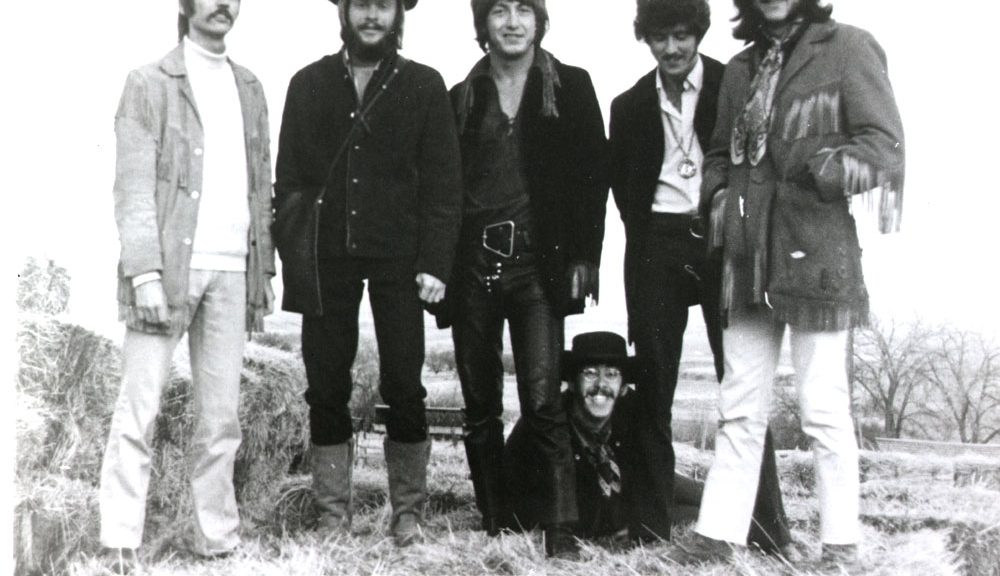
Randy Fuller left this message on 24 February 2009
I can’t remember when I first met Dewey, but I do remember when he offered me a job playing bass in the New Buffalo Springfield. I was thrilled to accept, as I loved the sound of the old Buffalo Springfield.
We toured the northwest area (Seattle) and during that time, I became very close to Dewey.
If I had been a top record producer, I would have signed Dewey immediately because of his magnetic personality to draw large audiences.
Dewey was a great singer and drummer, his fans loved him, and I know he inspired a lot of musicians. He truly was a wild and crazy guy, and I’ll never forget him!!
Was digging into what info I could find on trumpeter/producer Jim Price, who I’d known from Nilsson & George Harrison albums (usually in tandem with his partner-in-crime, Bobby Keys). My search was prompted by discovering he was the producer on one of my favorite albums, Wayne Shorter’s Native Dancer. Wiki provided some sketchy info which led me here.
Your was a very thorough article on the New Buffalo Springfield. Though short-lived, I don’t feel bad about not finding a trove of early Jim Price music there, but the info was very helpful. The search continues. Thanks for the sleuthing you did on this. I look forward to leafing through more articles on your site.
I was just reading this article because I recalled The New Buffalo Springfield preformed at my high school in either late 68 or early 69 at a dance. Homestead High School in Sunnyvale CA. I wanted to find out who the group members were at that time. Informative article.
I met them in Tacoma Washington when they played there in July 1969. I was hitchiking with a friend up the Pacific Coast and somehow connected with BJ who was from the same town I am Woodbury NJ. My good friend Greg Radcliffe from same place played guitar for Woodys Truckstop the local Philly Band and I met most of the famous rock stars who came to play at the Electric Factory or wherever Greg played while helping his wife Linda with their kids backstage. So long story short I think of them often because I spent the night sitting and talking with Randy Fuller about God and his family in Texas and how much he missed his wife and kids while on the road. I will never forget him. He helped me start back on the Right Way and shared about his faith in Jesus. I just saw that he passed last year and wish I could have seen this site sooner. We talked all night until dawn and I gave him a beautiful shell I had found and told him I would always remember him as a beautiful soul and many times he has come to mind over the years.